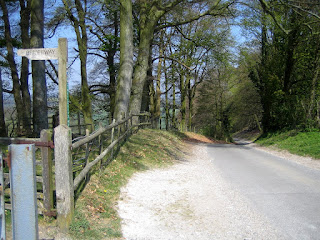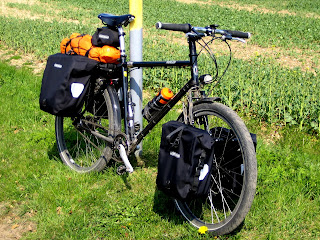Day 1 - To Reading (110 km)
The weather was perfect as I set off on my 5 day mini-tour with virtually full Canada kit; beautiful spring sunshine, temperature just right and a very light tailwind! I made good progress heading towards the Chilterns.Narrow boats at Marsworth
At Marsworth I stopped at the canal bridge and admired the colourful narrow boats moored into the distance. Soon after, I took lunch at the garden centre cafe in nearby Wilstone. Great food to refuel with and time to rest and soak up the sun!
Under the canal bridge
After lunch, I rode parallel to the Chiltern escarpment, before finally climbing steeply at Kingston Blount. Crawler gear 1 was engaged for the first time since getting the Nomad last year. Then again, it's the first 17% gradient I've attempted with a bike weighing nearly 40kg! I made it up easily enough.
Good refuelling is essential...
I needed more food after that and sat just off the fairway at Nuffield's golf course. This was not the smartest move, as the golfers were terrible! Slices and hooks galore, huge divots flying everywhere, golf balls clattering in trees, shouts of "fore", protracted searching in bushes and hedges. I moved on.
...so is resting after lunch
The landscape was wonderfully wooded and tranquil as I rode down the Chiltern "dip slope" - a mostly gentle downhill for the next 10km - until the final steep drop down to Pangbourne and the River Thames. Not too far to go now and I soon arrived at my aunt and uncle's house.
Christmas Common in the Chilterns
Day 2 - To Chandler's Ford (90 km)
Another perfect day weatherwise. Clear blue skies again! Today I headed south from Reading towards my sister's house in Chandler's Ford. I cycled on many little lanes throughout the day, the sun lighting up the new leaved trees and casting intricate shadows onto the road.Climbing up Watership Down
The morning's highlight was climbing Watership Down (the rabbit's destination in the famous book by Richard Adams). After a brief but tough climb, I was treated to a long descent towards Whitchurch.
At the top of Watership Down
At Whitchurch I had a quick photo stop at the Silk Mill, before pressing on for lunch at the White Lion in Wherwell. As yesterday, I had a fine lunch followed by a fine soak in the sun. (You've got to make the most of the sun in the UK).
Silk Mill, Whitchurch
When I finally got back on the road, I continued riding through the very pictureseque Test Valley with it's multitude of gentle slow flowing rivers and very pretty "chocolate box" villages.
River in the Test Valley
Reluctantly turning away from the valley, the run in to Chandler's Ford was tiring over the hills, but I twiddled away in a low gear and savoured the scenery and sun, before finally arriving at my sister's house mid-afternoon.
Very calming...
Day 3 - Day Off
Well I don't want to start off too heavily, do I? Anyway, I was quite worn out by two nephews aged 4 and 2...Day 4 - Back to Reading (90 km)
The day dawned a bit rainy, but it was clearing up when I left. The air was damp and muggy as a climbed a number of short sharp hills heading east of Winchester. After an hour, I crossed the River Itchen at Ovington and entered New Alresford. I had planned to drop into the Watercress Line station to use the cafe, but there was an even more enticing bakery open on the approach road!Church of St Mary the Virgin, Preston Candover
After tea and cakes (plural), I turned north and rode through the lovely rolling farmland of the Candovers and Axford, before arriving at Oakley where very good friends of mine live. As hospitable as always, Ken and Barbara plied me with fine food and drink as we caught up with each other's recent happenings and future plans.
Rape field. Aitchoo...
Good luck with your Magnificat Sportive (sponsored by Verenti) on the 13th June. Sorry I won't be around to drive the van this year!
From Oakley, it was a short ride back to Reading on very familiar roads. A bit of a tail-wind helped with the average speed again.
Day 5 - Back home (110 km)
One more day to go on my first mini-tour with full luggage! I mostly retraced my outward route, which meant a long climb back to Christmas Common at the top of the Chilterns. Just before, at Nuffield, I checked out the golfing action again to see if they'd improved at all. Nope.Cray's Pond
The hill I'd crawled up in first gear a couple of days ago now provided a thrilling descent. Now I know why heavy riders enjoy downhills so much. Saying that, on that hill even with the extra ballast, the Nomad was still not as fast as a racing bike.
Beacon Hill, Ivinghoe
Just to add a bit of spice to the return journey, I did a few miles off-road on a mixture of a rutted bye-way and some field margin. It was a bit bumpy because I didn't bother reducing my tyre pressures but it was enjoyable to be completely away from the traffic. I might have to explore this off-road business a bit more some day...
Bumpy field margin
I made it home safely and I was pretty satisfied with my first trial tour. The Nomad was faultless. My pannier packing needs some refinement to stop me hunting for things, but I'll soon nail that down. I found the riding (about 400km @ 21km/h) straightforward fitness-wise, but I still have minor issues with my saddle occasionally (and randomly) bruising my sit-bones and some mild hot spots from my shoes, although this has improved greatly since I changed to another pair that are stiffer soled.
Some more off-road. Hardcore!
So then, I'm happy and confident about the Canada trip from a cycling point of view. The next task is a camping trip where I can test my tent erecting skills, my one pot calorie replenishment skills, my amusing myself in the evening in a field skills and my ability to survive a couple of days possibly without a shower or electricity.































